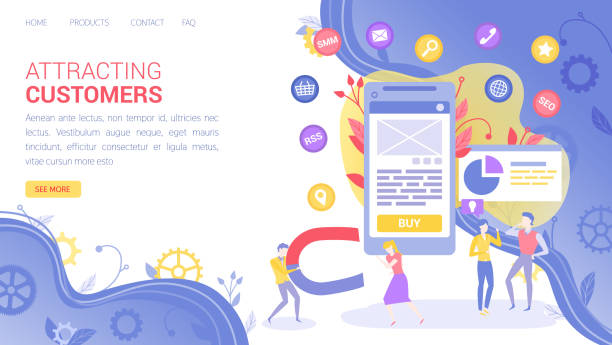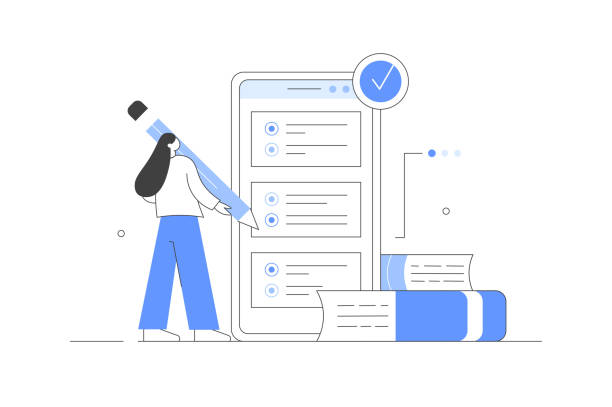Introduction to the Importance of Secure Website Design

In today’s digital world, where internet usage is increasing daily, #secure website design is no longer an option, but an undeniable necessity.
Website security not only means protecting sensitive user information and preventing data theft, but also maintaining user credibility and trust in your business.
A vulnerable website can be an easy target for malware, phishing attacks, and intruders, which can lead to the loss of vital data, financial damages, and serious harm to brand reputation.
Therefore, cybersecurity should be considered from the very beginning, i.e., in the initial stages of website design and development.
This section (explanatory and educational) examines this necessity and emphasizes how a proactive approach in secure website design can secure your digital future.
Ignoring this issue can have irreversible consequences, including the loss of users’ personal information, financial data, and even their identity.
Therefore, investing in a secure web structure is equivalent to investing in the long-term sustainability and success of your online business.
Website protection against increasing threats requires a comprehensive and up-to-date strategy that covers all technical and human aspects.
Is your current e-commerce website design not generating the expected sales for you?
Rasaweb is an expert in professional e-commerce website design!
✅ An attractive and user-friendly site aimed at increasing sales
✅ High speed and security for an ideal shopping experience⚡ Get free online store design consultation with Rasaweb!
Common Web Security Threats and Countermeasures

Understanding common threats is the first step in secure website design.
Websites are constantly exposed to various types of attacks.
One of the most common attacks is SQL Injection, which allows attackers to gain access to the database by injecting malicious code into input forms.
Cross-Site Scripting (XSS) is another type of attack where malicious JavaScript code is injected into the website and executed in users’ browsers.
DDoS (Distributed Denial of Service) attacks also render the server inaccessible by sending a huge volume of fake traffic.
Various approaches exist to counter these threats.
For SQL Injection and XSS, Input Validation and using ready-made, secure functions for database interaction are essential.
Against DDoS attacks, using DDoS protection services and Web Application Firewalls (WAFs) is recommended.
This section (analytical and guidance) helps you adopt effective preventive measures for your secure web structure by precisely understanding these risks.
Also, educating users to identify phishing and social engineering attacks is a crucial part of a comprehensive website security strategy.
This deep understanding of threats is the cornerstone of any successful effort in secure website design and helps development teams build website architecture based on the principle of “security from the ground up”.
Key Principles in Secure Website Design

Implementing key principles in the secure website design process is the most fundamental step for creating a reliable digital environment.
One of the most important of these principles is the use of the HTTPS protocol and SSL/TLS certificate, which encrypts the communication between the user’s browser and the server, preventing information eavesdropping.
The second principle is strict user input validation; never trust data received from users, and always filter and validate it before processing to prevent attacks such as SQL Injection and XSS.
The third principle is the use of strong passwords and appropriate security policies for password management (such as enforcing periodic password changes and using two-factor authentication).
Fourth, Session Security; ensure that session IDs are properly generated, managed, and expired.
Fifth, implementing appropriate Role-Based Access Control mechanisms so that each user only has access to resources they are authorized for.
This section (specialized and educational) provides you with practical solutions to strengthen your website’s security foundation.
Secure website design requires continuous attention to detail and adherence to international standards.
The table below refers to some of these principles:
| Security Principle | Explanation | Importance |
|---|---|---|
| HTTPS and SSL/TLS | Encrypting communication between user and server | Protection of privacy and data integrity |
| Input Validation | Filtering and sanitizing all user inputs | Prevention of SQL Injection and XSS |
| Session Management | Secure generation and management of session IDs | Prevention of session hijacking |
| Access Control | Restricting user access to authorized resources | Prevention of unauthorized access |
Server and Database Security in Secure Website Design

In addition to secure coding, server and database security also plays a vital role in secure website design.
Your website’s hosting server must be properly configured and protected.
This includes regular updates of the operating system and server software, disabling unnecessary services, and using hardware and software firewalls.
Furthermore, applying the Principle of Least Privilege for users and applications running on the server is important.
Regarding the database, you must ensure that access to it is restricted and only possible through authorized applications with strong credentials.
Encrypting sensitive information in the database, especially passwords and users’ personal information, using strong encryption algorithms, is an essential measure.
Regular and secure backups of the database and website files, and storing them in a secure and separate location, are crucial for information recovery in case of an attack or system failure.
This section (specialized and guidance) helps you create deeper security layers for your website.
Protecting backend infrastructure is as important as protecting the frontend and is one of the fundamental pillars for a strong web security protocol.
Neglecting these aspects can easily nullify all your efforts in other security areas and consequently jeopardize the secure web structure.
Are you dissatisfied with the low sales of your e-commerce website?
Rasaweb is your solution for having a professional and high-selling e-commerce website.
✅ Significant increase in sales and revenue
✅ Creating an easy and enjoyable shopping experience for customers
⚡ Get free consultation from Rasaweb now!
The Role of Updates and Security Patches

One of the key and often overlooked aspects in secure website design is the importance of regular updates and applying security patches.
Attackers are constantly discovering new vulnerabilities in operating systems, frameworks, libraries, plugins, and web templates.
Developers and software vendors address these security flaws by releasing updates and security patches.
Ignoring these updates can expose your website to known attacks for which solutions already exist.
This includes updating Content Management Systems (CMS) like WordPress, Joomla, or Drupal, plugins, themes, and any other server-side software.
Planning for regular updates and testing them in a development environment before applying them to the main website helps minimize disruptions.
(Informative and explanatory) This proactive and continuous approach to maintaining security is a vital element in website security.
Failure to update on time can lead to exploitation by attackers who take advantage of Common Vulnerabilities and Exposures (CVEs).
Therefore, creating a regular schedule for checking and applying updates is an integral part of the strategy for secure website design and its long-term maintenance.
This not only enhances security but also improves website performance and ensures compatibility with new technologies.
Penetration Testing and Vulnerability Assessment

To ensure a secure website design, relying solely on preventive measures is not enough; regular and proactive assessments are also essential.
Penetration Testing is a process where security professionals simulate cyberattacks to identify weaknesses and vulnerabilities before they are discovered by real attackers.
These tests can include black-box testing (without knowledge of internal structure) and white-box testing (with full access to source code and infrastructure).
Vulnerability Assessment is also a process that uses automated and manual tools to identify and report security vulnerabilities.
These assessments should be conducted periodically and also after any significant changes to the website’s infrastructure or code.
The findings from these tests help the development team address weaknesses and improve the website’s security level.
This section (analytical and specialized) clarifies the importance of an offensive approach in ensuring website security.
Regularly conducting these assessments ensures that your website remains resilient against new threats even after deployment.
Therefore, a portion of the secure website design cost should be allocated to these specialized tests to ensure the website’s readiness against potential attacks and to establish a stable secure web structure.
User and Access Management

One of the critical aspects of secure website design is the meticulous management of users and their access.
Applying the Principle of Least Privilege means that every user, whether a system administrator or a regular user, should only have access to the minimum resources and functions necessary to perform their tasks.
This approach, in case of a user account breach, prevents the spread of damage to other parts of the system.
The use of strong authentication systems, such as Two-Factor Authentication (2FA), is essential for all users, especially high-privilege users (administrators and developers).
Also, a clear policy for password management, including complexity, length, and expiration date, should be implemented.
(Explanatory and guidance) Monitoring user activity and reporting failed login attempts or suspicious activities can also help in rapid attack identification.
Proper access management minimizes internal and external risks and forms the backbone of a strong web security protocol.
In this regard, secure website design requires tools for efficient Identity and Access Management (IAM).
The table below illustrates some key aspects of user and access management:
| Topic | Importance | Solution |
|---|---|---|
| Principle of Least Privilege | Reducing damage scope in case of breach | Granting minimum necessary access to users |
| Two-Factor Authentication (2FA) | Increasing login security | Enforcing the use of secondary identity verification methods |
| Strong Password Policy | Preventing Brute Force attacks | Setting minimum length, special characters, periodic changes |
| Log Monitoring | Identifying suspicious activities | Regularly reviewing login and user activity reports |
Countering DDoS Attacks and Application Layer Attacks

Distributed Denial of Service (DDoS) attacks and application layer attacks are among the major challenges in secure website design.
DDoS attacks aim to make a service unavailable by overloading the server or network, while application layer attacks (Web Application Attacks), like SQL Injection and XSS previously mentioned, focus on the application’s own vulnerabilities.
To counter DDoS, it is essential to use specialized DDoS protection services (such as Cloudflare or Akamai) that filter and block malicious traffic.
These services can route traffic through their extensive networks and only send legitimate traffic to your server.
For application layer attacks, implementing a Web Application Firewall (WAF) is highly effective.
WAFs inspect HTTP requests before they reach the web application and block known attacks.
Additionally, secure coding and adherence to OWASP Top 10 standards in application development are other key measures for a secure web structure.
This section (specialized and guidance) provides advanced solutions for protecting websites against the most complex attacks.
Attention to these advanced measures complements efforts in secure website design from the ground up and ensures that the website is resilient against a wide range of threats, including targeted and complex attacks that can disrupt website performance and compromise critical information.
Are you dissatisfied with the low conversion rate of visitors to customers on your e-commerce website?
Solve this problem forever with professional e-commerce website design by Rasaweb!
✅ Increase visitor-to-customer conversion rate
✅ Create an excellent user experience and build customer trust
⚡ Get free consultation
Incident Response and Data Recovery

Even with the best secure website design approaches, the possibility of security incidents is not completely eliminated.
Therefore, having an Incident Response Plan is of paramount importance.
This plan should include specific steps for identification, containment, root cause analysis, recovery, and lessons learned from security incidents.
Rapid detection of intrusion or attack through monitoring and alert systems is the first step.
After that, measures should be taken to limit the scope of the attack to prevent further damage, for example, by isolating infected servers or cutting off attacker access.
Root cause analysis of the attack is vital to prevent its recurrence.
The recovery phase involves cleaning systems from malware and restoring information from secure backups.
Finally, incident analysis and learning from it are necessary to improve future security protocols and strengthen website security.
This section (guidance and explanatory) helps you to be prepared for worst-case scenarios and ensures that your business can quickly recover after a security incident.
Having a robust incident response plan demonstrates your commitment to a secure web structure and can maintain user trust even after a security breach.
This proactive strategy is an integral part of the secure website lifecycle and ensures business continuity even when facing challenges.
The Future of Secure Website Design and New Trends

The world of cybersecurity is constantly evolving, and with the emergence of new technologies, threats also become more complex.
Therefore, secure website design must also keep pace with new trends.
One such trend is the use of Artificial Intelligence (AI) and Machine Learning (ML) in cyber defense.
These technologies can identify suspicious traffic patterns with higher accuracy and automatically respond to threats.
Another is the increased use of blockchain technology to enhance transparency and security in data management and authentication.
API security has also become a priority due to the increasing reliance of websites on Application Programming Interfaces.
Furthermore, with the growth of the Internet of Things (IoT), websites may become hubs for IoT devices, which themselves can be entry points for attacks.
Finally, focusing on Security in Development (DevSecOps), which integrates security from the earliest stages of the software development lifecycle, will become a standard approach.
This section (thought-provoking and entertaining content) examines these future trends and how to prepare for them, demonstrating how a secure web structure must constantly evolve.
As technology advances, new challenges emerge that require innovative solutions in secure website design.
Frequently Asked Questions
And other services of Rasaweb advertising agency in the field of advertising
Introducing classic perfume vendors on industrial websites
Posting ads for long-lasting perfumes on digital websites
Advertising monthly perfume subscription services in industrial directories
Ads for herbal perfume sales on online platforms
Registering perfume bottle recycling services on technology websites
And over hundreds of other services in the field of internet advertising, advertising consulting, and organizational solutions
Internet Advertising | Advertising Strategy | Advertorials
🚀 Transform your business’s digital presence with Rasaweb’s internet advertising strategies and advertorials.
📍 Tehran, Mirdamad Street, Next to Central Bank, Southern Kazeroun Alley, Ramin Alley, No. 6

